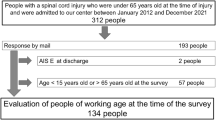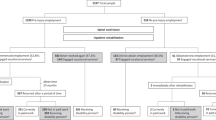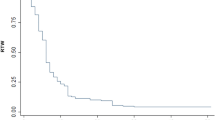Abstract
Study design
While clinicians who care for patients with spinal cord injury may experience heightened levels of workplace stress related to secondary trauma, little is known about the characteristics of burnout and potential protective factors among interdisciplinary professionals who care for this distinct clinical population. An online survey of self-reported burnout symptoms and meaning in work was conducted to assess the prevalence of burnout and characteristics of meaning in work among spinal cord injury professionals.
Objectives
To assess symptoms of professional burnout and meaning in work among a broad-ranging cohort of spinal cord injury clinicians and researchers.
Setting
A group of international spinal cord injury professionals.
Methods
An online survey was developed using commonly assessed metrics of burnout and meaning in work based upon prior literature.
Results
A majority of survey respondents reported feeling exhaustion (60.1%), while fewer reported feelings of burnout (41.1%) or work-life imbalance (31.9%). Many respondents found support in personal relationship from friends and family and reported using various strategies to deal with work stress, including exercise, meditation, and engaging in personally meaningful activities outside of work.
Conclusions
Exhaustion is a prevalent issue for many spinal cord injury professionals and burnout appears to be a significant issue for a subset of responders, yet despite potential workplace stressors, spinal cord injury professionals reported high meaningfulness of work, positive impact from colleagues, and satisfaction with intellectual stimulation at work.
Similar content being viewed by others
Log in or create a free account to read this content
Gain free access to this article, as well as selected content from this journal and more on nature.com
or
References
Taylor J, Bradbury-jones C, Breckenridge JP, Jones C, Herber OR. Risk of vicarious trauma in nursing research: a focused mapping review and synthesis. J Clin Nurs. 2016;25:2768–77.
Newell JM, Nelson-gardell D, Macneil G. Clinician responses to client traumas: A chronological review of constructs and terminology. Trauma Violence Abus. 2016;17:306–13.
Bianchi R, Schonfeld IS. Defining physician burnout, and differentiating between burnout and depression-I. Mayo Clin Proc. 2017;92:1455.
Shanafelt TD, Noseworthy JH. executive leadership and physician well-being: nine organizational strategies to promote engagement and reduce burnout. Mayo Clin Proc. 2017;92:129–46.
Shanafelt TD, Boone S, Tan L, Dyrbye LN, Sotile W, Satele D. et al. Burnout and satisfaction with work-life balance among US physicians relative to the general US population. Arch Intern Med. 2012;172:1377–85.
Shanafelt TD, Hasan O, Dyrbye LN, et al. Changes in burnout and satisfaction with work-life balance in physicians and the general US working population between 2011 and 2014. Mayo Clin Proc. 2015;90:1600–13.
Dyrbye LN, West CP, Satele D, et al. Burnout among U.S. medical students, residents, and early career physicians relative to the general U.S. population. Acad Med. 2014;89:443–51.
Shanafelt TD, Gradishar WJ, Kosty M, et al. Burnout and career satisfaction among US oncologists. J Clin Oncol. 2014;32:678–86.
Shanafelt TD, Dyrbye LN, West CP, Sinsky CA. Potential impact of burnout on the US physician workforce. Mayo Clin Proc. 2016;91:1667–8.
Sinsky CA, Dyrbye LN, West CP, Satele D, Tutty M, Shanafelt TD. Professional satisfaction and the career plans of US physicians. Mayo Clin Proc. 2017;92:1625–35.
Swensen S, Kabcenell A, Shanafelt T. Physician-organization collaboration reduces physician burnout and promotes engagement: The Mayo Clinic Experience. J Health Manag. 2016;61:105–27.
Rotenstein LS, Torre M, Ramos MA, et al. Prevalence of burnout among physicians: a systematic review. JAMA. 2018;320:1131–50.
Burghi G, Lambert J, Chaize M, et al. Prevalence, risk factors and consequences of severe burnout syndrome in ICU. Intensive Care Med. 2014;40:1785–6.
Hlubocky FJ, Back AL, Shanafelt TD. Addressing burnout in oncology: why cancer care clinicians are at risk, what individuals can do, and how organizations can respond. Am Soc Clin Oncol Educ Book. 2016;35:271–9.
Shanafelt TD, Dyrbye LN, West CP. Addressing physician burnout: the way forward. JAMA. 2017;317:901–2.
Shanafelt T, Swensen S. Leadership and physician burnout: using the annual review to reduce burnout and promote engagement. Am J Med Qual. 2017;32:563–5.
Author information
Authors and Affiliations
Corresponding author
Ethics declarations
Conflict of interest
The authors declare that they have no conflict of interest.
Additional information
Publisher’s note: Springer Nature remains neutral with regard to jurisdictional claims in published maps and institutional affiliations.
Supplementary information
Rights and permissions
About this article
Cite this article
Slocum, C., Stillman, M., Capron, M. et al. International survey responses from an interdisciplinary cohort of spinal cord injury clinicians assessing professional burnout and meaning in work. Spinal Cord Ser Cases 5, 59 (2019). https://doi.org/10.1038/s41394-019-0200-1
Received:
Revised:
Accepted:
Published:
DOI: https://doi.org/10.1038/s41394-019-0200-1



